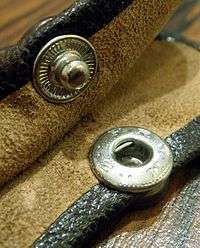Snap fastener

A snap fastener (also called press stud, popper, snap or tich) is a pair of interlocking discs, made out of a metal or plastic, commonly used in place of buttons to fasten clothing and for similar purposes. A circular lip under one disc fits into a groove on the top of the other, holding them fast until a certain amount of force is applied. Different types of snaps can be attached to fabric or leather by riveting with a punch and die set specific to the type of rivet snaps used (striking the punch with a hammer to splay the tail), sewing, or plying with special snap pliers.
Snap fasteners are a noted detail in American Western wear and are also often chosen for children's clothing, as they are relatively easy for children to use.
Invention

Modern snap fasteners were first patented by German inventor Heribert Bauer in 1885 as the "Federknopf-Verschluss", a novelty fastener for men's trousers. Some attribute the invention to Bertel Sanders, of Denmark. These first versions had an S-shaped spring in the "male" disc instead of a groove.[1] Australian inventor Myra Juliet Farrell is also credited with inventing a 'stitchless press stud' and the 'stitchless hook and eye.'[2] In America, Jack Weil (1901–2008) put snaps on his iconic Western shirts, which spread the fashion for them.[3] The Prym-company produces snap fastners since 1903.
Usage
China
In the famous Chinese Terracotta Army, dating from 210 BC, the horse halters of wagons, made of a gold tube and a silver tube, were joined with a form of snap fasteners.
In Western fashion

Press studs were worn by rodeo cowboys from the 1930s onwards, because these could be quickly removed if, in the event of a fall, the shirt became snagged in the saddle. Pearl snaps entered American mainstream Western fashion during the 1950s, when singing cowboys like Gene Autry and Roy Rogers incorporated them into their embroidered and fringed stage shirts. The most desirable shirts were unique creations tailored by Nudie Cohn or Rodeo Ben, but commercially produced Western clothing could be purchased from companies like Wrangler, Levi Strauss, Panhandle Slim, Rockmount Ranch Wear, H Bar C, or Roper.[4]
Due to the popularity of Spaghetti Westerns, cowboy shirts with oversized collars were widely worn by teenagers and young adults from the mid 1960s until the early 1980s.[5] By the 1990s, however, press studs had become associated with the adaptable clothing worn by pensioners and the disabled. During the late 2000s and 2010s, however, shirts with Western detailing made a comeback in Europe and the southern US due to the popularity of indie rock and a resurgence of interest in vintage Americana.[6]
Gallery
 Four pieces of a typical rivet snap fastener
Four pieces of a typical rivet snap fastener Tools used to apply a snap
Tools used to apply a snap_side_components.jpg) Female side parts of riveted fastener
Female side parts of riveted fastener_side_components.jpg) Male side parts of riveted fastener
Male side parts of riveted fastener
References
- ↑ "Zwei Köpfe und ein Knopf". Westdeutscher Rundfunk (in German). March 5, 2005. Retrieved 8 July 2013.
- ↑ "Woman Inventor". Western Age (Dubbo, NSW: 1914 - 1932) . Dubbo, NSW. 28 August 1915. p. 4. Retrieved 24 February 2014.
- ↑ "Story of Rockmount Ranch Wear". Retrieved 2011-01-29.
- ↑ 100 years of Western wear
- ↑ Western shirts
- ↑ Western wear revival